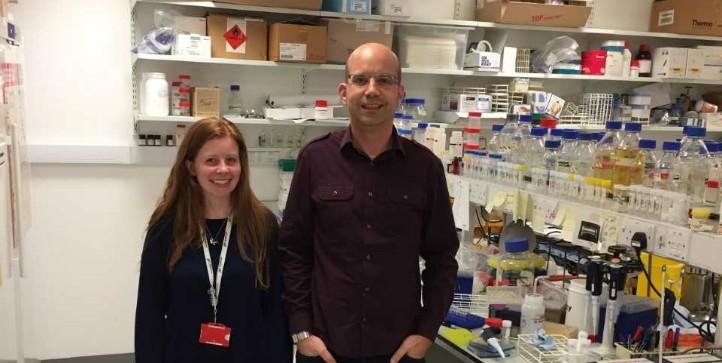
Enzymes used by bacteria to break down mucus in the gut could provide a useful biomarker for intestinal diseases, according to new research published in Nature Communications.
Researchers at the University of Birmingham and Newcastle University have successfully identified and characterised one of the key enzymes involved in this process. They demonstrated how the enzyme enables bacteria to break down and feed off sugars in the layers of mucus lining the gut.
The research offers a significant step forward in our understanding of the complex co-dependent relationships at work in the gut, about which little is currently known. Because the mechanism used by the enzyme is particularly distinctive, the researchers anticipate it can be used in the development of new diagnostics for intestinal diseases.
The molecules in mucus, called mucin, are constantly produced by the body to generate the layer of mucus in the gut that provides a barrier between the gut’s complex populations of bacteria and the rest of the body. Mucin contain chains of sugar molecules called glycans, and these also provide an essential source of nutrients for bacteria.
The team investigated how this enzyme sits on the outside of the bacterial cell and clips away parts of the mucin molecule, taking them inside the bacterial cell to be consumed.
Because glycans are known to change when certain diseases are present in the body, the researchers anticipate it will be possible to use the enzymes to take a snapshot of the glycans within a biopsy and use that as a biomarker for early detection of the disease.
The research was led by Dr Lucy Crouch, of the University of Birmingham’s School of Biosciences, and Dr David Bolam, in the Biosciences Institute at Newcastle University. Dr Crouch explains: “Mucus is structured a bit like a tree, with lots of different branches and leaves. Lots of the enzymes discovered so far might clip away some of the leaves to eat, but the enzyme we studied will clip away a whole branch – that’s quite a distinctive mechanism and it gives us a useful biomarker for studying disease.”
The team have investigated this process in three different diseases. They examined tissue from adults suffering from ulcerative colitis and colorectal cancer, and from preterm infants with necrotising enterocolitis, a serious illness in which the gut becomes inflamed and can start to die. They found that by adding the enzyme to the samples and labelling the glycans with a fluorescent dye, they were able to get useful information about the glycan structure.
Dr Crouch adds: “Although we still don’t fully understand what the glycan structures are made from and how these vary between different tissue types, we can see that the differences in structure between health and non-healthy tissue is quite distinctive. We hope to be able to use these enzymes to start producing better diagnostics for the very early stages of these diseases.”
For media enquiries please contact Beck Lockwood, Press Office, University of Birmingham, tel: +44 (0)781 3343348.
- The University of Birmingham is ranked amongst the world’s top 100 institutions. Its work brings people from across the world to Birmingham, including researchers, teachers and more than 6,500 international students from over 150 countries.
- Crouch et al (2020). ‘Prominent members of the human gut microbiota express endo-acting O-1 glycanases to initiate mucin breakdown’. Nature Communications. DOI: 10.1038/s41467-020-17847-5